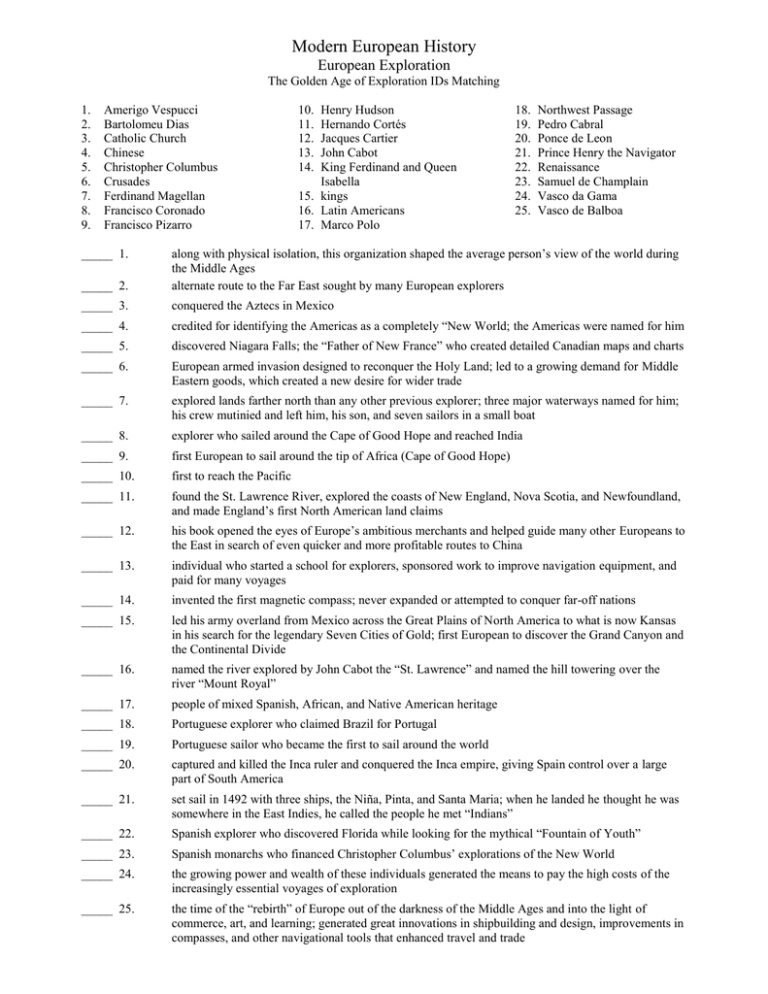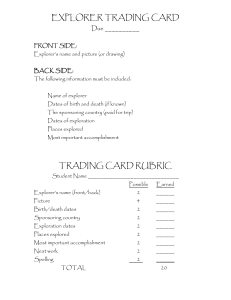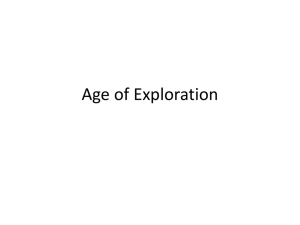Modern European History European Exploration
advertisement

Modern European History European Exploration The Golden Age of Exploration IDs Matching 1. 2. 3. 4. 5. 6. 7. 8. 9. Amerigo Vespucci Bartolomeu Dias Catholic Church Chinese Christopher Columbus Crusades Ferdinand Magellan Francisco Coronado Francisco Pizarro 10. 11. 12. 13. 14. Henry Hudson Hernando Cortés Jacques Cartier John Cabot King Ferdinand and Queen Isabella 15. kings 16. Latin Americans 17. Marco Polo 18. 19. 20. 21. 22. 23. 24. 25. Northwest Passage Pedro Cabral Ponce de Leon Prince Henry the Navigator Renaissance Samuel de Champlain Vasco da Gama Vasco de Balboa _____ 2. along with physical isolation, this organization shaped the average person’s view of the world during the Middle Ages alternate route to the Far East sought by many European explorers _____ 3. conquered the Aztecs in Mexico _____ 4. credited for identifying the Americas as a completely “New World; the Americas were named for him _____ 5. discovered Niagara Falls; the “Father of New France” who created detailed Canadian maps and charts _____ 6. European armed invasion designed to reconquer the Holy Land; led to a growing demand for Middle Eastern goods, which created a new desire for wider trade _____ 7. explored lands farther north than any other previous explorer; three major waterways named for him; his crew mutinied and left him, his son, and seven sailors in a small boat _____ 8. explorer who sailed around the Cape of Good Hope and reached India _____ 9. first European to sail around the tip of Africa (Cape of Good Hope) _____ 10. first to reach the Pacific _____ 11. found the St. Lawrence River, explored the coasts of New England, Nova Scotia, and Newfoundland, and made England’s first North American land claims _____ 12. his book opened the eyes of Europe’s ambitious merchants and helped guide many other Europeans to the East in search of even quicker and more profitable routes to China _____ 13. individual who started a school for explorers, sponsored work to improve navigation equipment, and paid for many voyages _____ 14. invented the first magnetic compass; never expanded or attempted to conquer far-off nations _____ 15. led his army overland from Mexico across the Great Plains of North America to what is now Kansas in his search for the legendary Seven Cities of Gold; first European to discover the Grand Canyon and the Continental Divide _____ 16. named the river explored by John Cabot the “St. Lawrence” and named the hill towering over the river “Mount Royal” _____ 17. people of mixed Spanish, African, and Native American heritage _____ 18. Portuguese explorer who claimed Brazil for Portugal _____ 19. Portuguese sailor who became the first to sail around the world _____ 20. captured and killed the Inca ruler and conquered the Inca empire, giving Spain control over a large part of South America _____ 21. set sail in 1492 with three ships, the Niña, Pinta, and Santa Maria; when he landed he thought he was somewhere in the East Indies, he called the people he met “Indians” _____ 22. Spanish explorer who discovered Florida while looking for the mythical “Fountain of Youth” _____ 23. Spanish monarchs who financed Christopher Columbus’ explorations of the New World _____ 24. the growing power and wealth of these individuals generated the means to pay the high costs of the increasingly essential voyages of exploration _____ 25. the time of the “rebirth” of Europe out of the darkness of the Middle Ages and into the light of commerce, art, and learning; generated great innovations in shipbuilding and design, improvements in compasses, and other navigational tools that enhanced travel and trade _____ 1.


